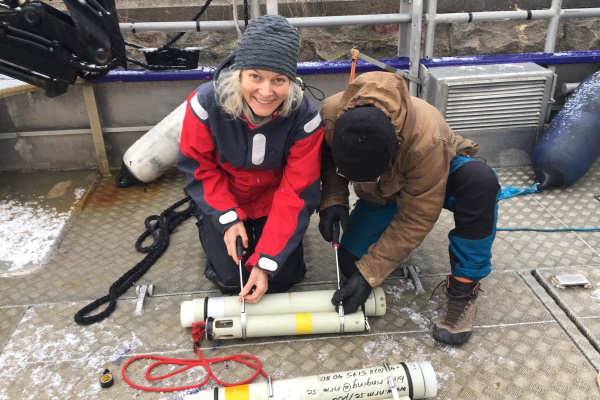Harbour porpoise monitoring

C-PODs being prepared for deployment. Photo credit: Emilia Lalander
Why do we monitor harbour porpoises?
Under EU legislation (the Habitats Directive and the Marine Strategy Framework Directive), all Member States are required to complete monitoring and reporting on the status of harbour porpoises. The harbour porpoise is the only resident species of cetacean in Swedish waters, yet cetaceans play an important role in ecosystem health and functioning.
Therefore, understanding possible changes in the abundance and distribution of harbour porpoise populations is important to understand other ecosystem-level impacts. The Swedish Museum of Natural History is responsible for completing the Swedish National Monitoring program on harbour porpoises on behalf of the Swedish Agency for Marine and Water Management (SwAM).
How do we monitor harbour porpoises?
We monitor harbour porpoises by passive acoustic monitoring (PAM), that is we listen for them, by anchoring acoustic data loggers (C-PODs) in specific locations. PAM is particularly useful for harbour porpoises since they produce narrow-band high-frequency (NBHF) clicks almost continuously in order to find prey, communicate, and navigate, but spend little time close to the surface and can be difficult to observe.
Given the very low population size of the Baltic Proper population of harbour porpoises (approximately 500), sightings of the species within the Baltic Sea are incredibly rare. The harbour porpoise clicks are easily identified from other underwater sounds, which makes it possible for us to measure the relative occurrence of harbour porpoises at each monitoring station and analyse changes over time.
Where do we monitor harbour porpoises?
We currently complete PAM in two areas as a part of the Swedish national monitoring program. We began up in the Baltic Sea in 2017, where we currently have 11 stations primarily to monitor the Baltic Proper population. In the Kattegat Sea, since 2019 we have 14 stations that are primarily used to monitor the Belt Sea population. Some of the stations are located within Natura 2000 sites that have been designated to protect harbour porpoises.
In addition to the harbour porpoise monitoring stations run by the Swedish Museum of Natural History, we collaborate with the Swedish Defence Research Agency (FOI) who monitors underwater noise at one station at the Northern Midsea Bank in the Baltic Sea and one station close to the island of Hönö west of Gothenburg. At these stations, underwater noise and harbour porpoises are monitored jointly.
What do we do with the results?
All data collected as a part of the national monitoring program are delivered to the Swedish Meteorological and Hydrological Institute (SMHI) and HELCOM. They are made publicly available via Sharkweb and HELCOM's Biodiversity database.
In 2020, we completed an analysis comparing the detection rates at the stations in the Baltic Sea during the national monitoring program (2017-2020) to the detection rates at the same stations collected during a previous research project called SAMBAH (2011-2013). This enabled us to demonstrate that the detection frequency of this Critically Endangered population has actually increased over the last decade, with an average rise of 2.4% per year.
Although this is positive news, the rate of increase is well below what is possible for a healthy harbour porpoise population in the absence of threats. Additionally, as harbour porpoises are highly mobile, it is not possible to know if an increase at a smaller number of stations truly reflects an actual increase in the entire population size. The results strongly point to the need for population-wide surveys, and that measures to protect the population need to be implemented to allow it to recover.
Together with national monitoring data from other countries, the data are used for developing indicators to assess the status of harbour porpoise populations, and how they change over time. The results of the national monitoring program are also presented at conferences, such as Vattenmiljöseminariet.
Other associated work
The Swedish Museum of Natural History also provides expert advice to the Regional Monitoring program on harbour porpoises, which is under development by the County Administrative Boards. We also contributed to the development and completion of the MiniSCANS-II survey (2020), a visual aerial survey assessing the abundance and distribution of the Belt Sea population.
Additionally, we are involved in the planning of SCANS-IV, a visual abundance survey of harbour porpoises in the North Sea and adjacent waters, including the Belt Sea.
Period
2017 – ongoing
Funding
Publications
Carlström, J., Owen, K. 2020. Tumlarövervakning vid NRM. Videopresentation vid Vattenmiljöseminariet. https://havsmiljoinstitutet.se/seminarier/vattenmiljoseminariet .
.
Owen, K., Sköld, M., Carlström, J., 2021. An increase in detection rates of the critically endangered Baltic Proper harbor porpoise in Swedish waters in recent years. Conserv. Sci. Pract. 3, e468. https://doi.org/10.1111/csp2.468 .
.
Owen K., Carlström J. (2021) Vanlig tumlare inte vanlig i Östersjön . Art i fokus på Sveriges vattenmiljö. Sveriges vattenmiljöer .
.
Unger, B., Nachtsheim, D. Ramírez Martínez, N., Siebert, U., Sveegard, S., Kyhn, L., Balle, J.D., Teilmann, J. Carlström, J., Owen, K., Gilles, A. 2021. MiniSCANS-II: Aerial survey for harbour porpoises in the western Baltic Sea, Belt Sea, the Sound and Kattegat in 2020. Joint survey by Denmark, Germany, Sweden. Final report to the Danish Environmental Protection Agency, German Federal Agency for Nature Conservation, and the Swedish Agency for Marine and Water Management. 28 pp.


